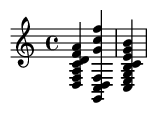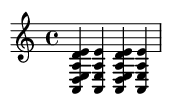Summary:
Suspended chords, or "sus" chords, are a vital tool for any songwriter, composer, or musician. By replacing the defining third of a chord with either a more neutral second (sus2) or a tense fourth (sus4), they create a unique sense of ambiguity, anticipation, and forward motion. This comprehensive guide delves into their music theory foundations, common variations, and practical applications across genres like folk, rock, and jazz. Through clear explanations, professional musical examples, and practical exercises, you will learn to master suspended chords and elevate your harmonic vocabulary.
Keywords:
suspended chords, sus2, sus4, 7sus4, music theory, chord progressions, harmonic tension, resolution, songwriting, guitar chords, piano chords, modal harmony
What Are Suspended Chords?
In the world of harmony, the third scale degree is the heart of a triad, defining its character as either major (happy, bright) or minor (sad, dark). A suspended chord intentionally removes this character-defining third and replaces it with a different note, creating a sound that is neither major nor minor. This "suspense" leaves the listener waiting for resolution, making it a powerful device for creating musical interest.
The two primary types of suspended chords are:
- Sus4 Chord: The third is replaced by the perfect fourth (P4) above the root. The formula is Root - P4 - P5. This is the most common type, creating a distinct, often strong tension that pulls towards resolution.
- Sus2 Chord: The third is replaced by the major second (M2) above the root. The formula is Root - M2 - P5. This chord has a more open, airy, and modern sound, with a gentler sense of ambiguity than the sus4.
Example: C Major, Csus4, and Csus2
Listen to the difference. The C major chord feels stable. The Csus4 feels tense, like it wants to move to the C major. The Csus2 feels open and contemplative.

Historical Context: From Classical Suspension to Modern Sonority
Classical Origins
The term "suspension" originates from a specific contrapuntal technique in classical music. It involves a three-step process: Preparation (the note is part of a consonant chord) , Suspension (the note is held over as the harmony changes, creating dissonance), and Resolution (the dissonant note steps down to become part of the new chord). The 4-3 suspension (where the fourth resolves down to the third) is the direct ancestor of the modern sus4 chord.
Modern Evolution
In contemporary music (from the 20th century onwards), suspended chords broke free from this strict need for preparation and resolution. Musicians in folk, rock, and jazz began using them as standalone sonorities. Instead of just creating momentary tension, the suspended chord became a color and a texture in its own right, valued for its ambiguous, floating quality.
Common Variations and Extended Suspended Chords
Beyond the basic sus2 and sus4, adding sevenths and other extensions opens up a rich palette of sounds.
- 7sus4 Chord: A sus4 triad with a minor seventh (m7) added (Root - P4 - P5 - m7). This is a cornerstone of jazz and funk harmony. It frequently functions as a substitute for a dominant 7th chord, softening its harshness while retaining its forward-pulling function.
- 9sus4 Chord: A 7sus4 chord with a major ninth (M9) added (Root - P4 - P5 - m7 - M9). This creates a lush, complex, and modern sound often used in jazz fusion and R&B.
Example: G7sus4 resolving in a ii-V-I Progression
Notice how the G7sus4 (G-C-D-F) smoothly resolves to a G7 (G-B-D-F) before landing on Cmaj7. This is a classic jazz progression.

How to Use Suspended Chords: Practical Applications
1. Creating Motion Through Resolution
This is the most traditional and intuitive way to use sus chords. You play the suspended chord first, creating tension, and then resolve it to its corresponding major or minor chord. This creates a satisfying sense of forward movement.
- Sus4 Resolution: The 4th resolves down by a half step (in major keys) or a whole step (in minor keys) to the 3rd. Ex: `Csus4 -> C` or `Csus4 -> Cm`.
- Sus2 Resolution: The 2nd resolves up by a half step (in minor keys) or a whole step (in major keys) to the 3rd. Ex: `Csus2 -> C` or `Csus2 -> Cm`.
Example: Classic Sus4 and Sus2 Resolutions

2. Adding Color as a Standalone Chord
In many modern songs, sus chords don't resolve at all. They are used for their unique, open sound. This creates a kind of harmonic "wash" or a pedal point effect where the harmony feels both grounded and floating. A classic example is the opening of "Free Fallin'" by Tom Petty, which oscillates between F, Fsus4, and C chords.
Example: Folk-Style Sus Chord Embellishment
On guitar, it's common to embellish a standard chord by briefly adding a sus4 or sus2. This progression moves from D major to Dsus4, then to Dsus2 and back to D, creating rhythmic and harmonic interest without changing the underlying chord function.

3. Creating Powerful Rock Riffs
The strong, driving sound of a sus4 chord resolving to a major chord or a power chord is a staple of rock music. The tension and release create a powerful, punchy effect. The intro to "Pinball Wizard" by The Who is a masterclass in building a riff around sus4 chords.
Example: A Classic Rock Sus4 Riff
This riff alternates between an Asus4 and an A major power chord (A5) , creating a dynamic and powerful sound.

Common Voicings for Your Instrument
Guitar Voicings
Sus chords are particularly guitar-friendly, often requiring only a one-finger change from a standard major or minor chord.
Asus2: x02200 A major: x02220 Asus4: x02230 Dsus2: xx0230 D major: xx0232 Dsus4: xx0233 Esus4: 022200 E major: 022100 G_sus4: 3x001x (a common "Cadd9/G" voicing often used as Gsus4)
Piano Voicings
On piano, you have the flexibility to voice sus chords in many ways, from tight root position to wide, open voicings.
// C Suspended Chords Csus2 (Root Position): C-D-G Csus4 (Root Position): C-F-G C7sus4 (Common Voicing): C-F-G-Bb (or G-C-D-F in an inversion) // Open Voicings (spread across octaves) Dsus2 (Open): D (left hand), A-E (right hand) Gsus4 (Open): G (left hand), D-G-C (right hand)
Practice Approaches and Exercises
Exercise: Integrating Sus Chords into a Progression
Practice the following progression. The goal is to feel how the sus chords act as "decorations" or "passing chords" that add interest to a standard progression. Play it slowly and listen to the effect of each sus chord.

Advanced Concepts and Modal Harmony
Suspended chords are fundamental to modal music, where harmony is often static and color-based rather than functional. Their lack of a strong major/minor pull allows them to establish the sound of a mode without constantly resolving.
- Mixolydian Mode: The V7sus4 chord is quintessentially Mixolydian. Vamping on a 7sus4 chord is a classic way to establish a Mixolydian feel (e.g., vamping on G7sus4 in the key of C) .
- Dorian Mode: The open, slightly melancholic sound of sus2 chords fits perfectly with the Dorian character. Progressions like `i - IVsus2` (e.g., `Am - Dsus2`) are common.
- Quartal Harmony: The sound of a sus4 chord is closely related to quartal harmony (chords built from fourths instead of thirds). A C-F-G chord can be seen as a stack of a perfect fourth (C-F) and a major second (F-G), or as a quartal chord G-C-F with G in the bass. This connection is heavily explored in the music of pianists like McCoy Tyner.
Conclusion: Your New Harmonic Tool
Suspended chords are far more than a simple music theory oddity; they are an expressive and versatile tool in any musician's kit. They can function as a source of tension demanding release, or as a stable, beautiful sonority in their own right. By understanding their structure and exploring their use in different contexts, you can add new layers of color, motion, and emotional depth to your music. Start experimenting today—try replacing a major or minor chord in a familiar song with its sus4 or sus2 counterpart, and listen to the new world of harmony that opens up.
References:
Levine, M. (1995). The Jazz Theory Book. Sher Music Co.
Goodrick, M. (1987). The Advancing Guitarist. Hal Leonard.
Persichetti, V. (1961). Twentieth-Century Harmony: Creative Aspects and Practice. W. W. Norton & Company.
Mulholland, J., & Hojnacki, T. (2013). The Berklee Book of Jazz Harmony. Berklee Press.
